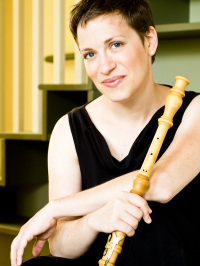by Mike Telin

On Saturday, January 17 at 8:00 pm in William Busta Gallery, and on Sunday, January 18 at 4:00 pm in Plymouth Church, Les Délices, in collaboration with Blue Heron Ensemble, Scott Metcalfe, director, will present a fascinating concert entitled Fourteenth Century Avant-Garde. The performances will feature Les Délices regulars Scott Metcalfe (vielle & gothic harp) and Debra Nagy (recorders & douçaines) with special guest artists Martin Near, countertenor, and Jason McStoots, tenor. On Sunday Metcalfe will give a pre-concert lecture beginning at 3:00 pm.
“I think this is going to be a really cool and enjoyable concert,” Nagy exclaimed. “There’s a lot of variety in what might appear to be a very heavy program.” Nagy says that an unprecedented freedom of thought, the fearless exploration of rhythmic complexity, and a desire to explore the limits of what is possible are central to this avant-garde repertory, which has been dubbed Ars Subtilior, or “More Subtle Art.”
How does she explain this “experimental” music? “There are a few perspectives that I could take. One is to relate it to composers people already know and love, and who also exploited intellectual possibilities in very real ways. The first person to come to mind is J.S. Bach. Think about his control over fugue, the way he put nearly impossible chromatic fugal subjects in every possible combination like augmentation, diminution, retrograde and inversion. Also the way he conceived the Well-Tempered Clavier – a work in which he explores all of the possible keys in a world without equal temperament. I also think about other musics that are potentially expressive, yet built on an abstract system – for example the serial music of Schoenberg and Webern.”

Baude Cordier’s circular canon, Tout par compas suy composés, from the Chantilly Manuscript.
Nagy pointed out that for the Ars Subtilior composers, two things were at play. One was about exploring the limits of possibility, and the other was about playing games. “When you see how a composer would use the same notational system to express different things, in a way it becomes a riddle to be solved. In fact, many of the pieces came with directions, which were basically little riddles. The actual word for that is “canon.” Today we think of canon as something very literal – one voice chasing another. But to them, canon was any kind of written direction that helped you decode the piece.” Nagy thinks it is important to remember that this era in Europe, particularly in France and Italy, was a period of intellectual independence. “This was the moment in history when the great universities were being founded. It was a time when intellectuals were attempting to understand their world. First, they needed to understand it with respect to God, who is omnipotent and created all things. Some of those things we can observe, some we cannot. He must have created everything that is intellectually possible too, we just can’t see it. They were obsessed with finding a way to explain all things that could possibly exist in the world.”
Respecting God also influenced the way composers looked at musical notation. “They were trying to find a way to explain that as well. Today it’s very obvious to us that a whole note is made up of two half notes. But to them, a whole note could also add up to three half notes — in fact that was sort of preferred. That too had to do with religion. God created perfect things and the Holy Trinity is perfect, so perfect things come in threes. So there was a point when dividing something musical into two as opposed to three was very counter-cultural.”
Next week Debra Nagy discusses the music that will be performed on the program. But until then, perhaps you can ponder over these musical scores by Baude Cordier (ca. 1380-ca. 1440).

Baude Cordier’s chanson, Belle, Bonne, Sage from the Chantilly Manuscript
Published on ClevelandClassical.com January 6, 2015.
Click here for a printable copy of this article



